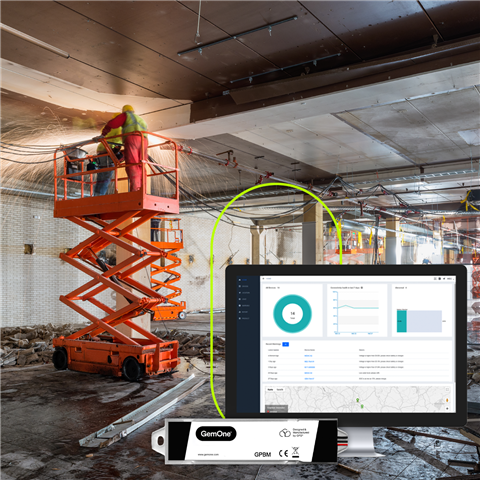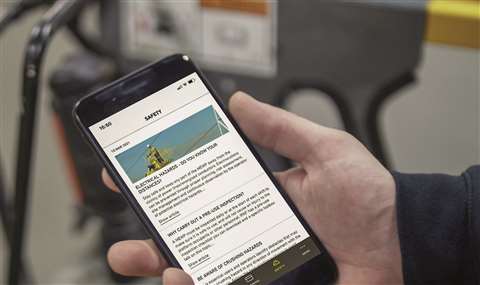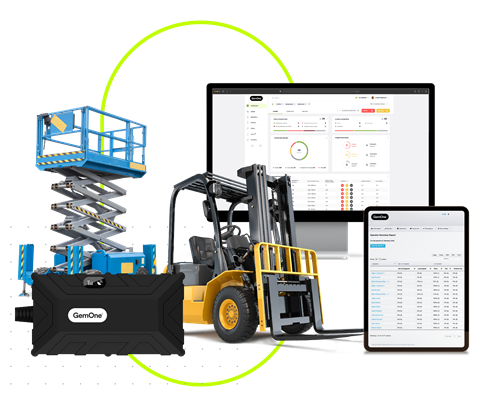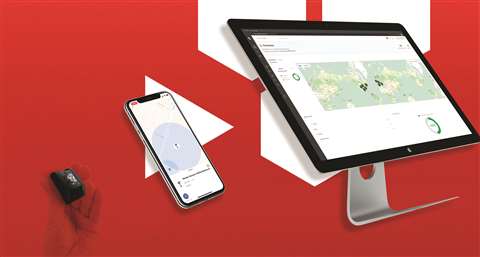Rental software: how can it improve access fleet efficiency?
27 February 2023
Analytical fleet management is becoming a necessity for long term profitability.
Digital transformation, and the use of rental software have both been at the core of many rental strategies for some time, and it’s a key driver from a product strategy perspective, says inspHire.
 GemOne’s Battery Monitoring Solution. (Photo: GemOne)
GemOne’s Battery Monitoring Solution. (Photo: GemOne)
Being able to react dynamically to rapidly changing market conditions is key. Not only are businesses being asked to be more sustainable, inflationary pressures are causing costs to increase.
Martin Bestwick, sales director of inspHire, says, “Measuring asset return on investment and business performance accurately during these times is paramount.
“Although rental rates might be slightly higher than others, smart rental businesses are providing their customers with a better service – whether it’s by giving them reminders to off-rent equipment.”
This can be achieved by using inspHire’s alerts system or using the in-depth inspHire APIs to create their own inter-connected customer ecosystem.
Another service, inspHire Corporate allows rental companies to unify and standardise complex processes spread over many business units or geographies into one central rental management enterprise resource planning (ERP) system.
Companies such as Boels, Riwal, Algeco and Hirepool all have inspHire Corporate at the heart of their businesses.
In light of this, inspHire continues to add new features to its Mobile application to increase these efficiencies further.
This includes real-time on-location processes such as PODs, repairs, services and vehicle inspections.
At the same time, these new features also help reduce operational costs by assisting customers in scaling down the use of manual paper documentation.
One of inspHire’s latest products was launched at the Executive Hire Show, which took place in the UK in early February, is the WebPro.
The ecommerce solution provides an off-the-shelf B2B/B2C web presence, allowing rental companies to compete online and offline.
“We see this as a game changer for the SME rental company,” says Bestwick. “Historically, implementing such an integrated webshop window was either very costly or limited in terms of true ecommerce functionality.
“We believe WebPro will provide the SME rental/hire businesses with tools to grow their business through the ability to extend their product catalogue and start taking orders for the first time online.”
ePAL operator app reaches milestone
 IPAF’s ePAL mobile app for MEWP operators. (Photo: IPAF)
IPAF’s ePAL mobile app for MEWP operators. (Photo: IPAF)
IPAF’s ePAL mobile app for operators of MEWPs and mast climbing platforms has now surpassed a quarter of a million first-time downloads.
The app was launched in June 2021, and developed with Trackunit, with the global roll-out completed in 2022.
The app allows digital certification of training, including IPAF’s Powered Access Licence (PAL) Card. It is free to use and is available in seven languages.
The app allows IPAF to communicate safety messages to operators around the globe. It also offers benefits to users in terms of storing and sharing training certification and logging machine time, and reporting incidents or near-misses to IPAF’s portal.
The app is available in all territories where IPAF certifies training, and to date has active users in more than 160 countries worldwide.
Peter Douglas, IPAF’s CEO and managing director, commented, “We developed ePAL in partnership with our member firm Trackunit in part to offer operators and supervisors a digital tool to share training certification and log equipment time, and also as part of our ongoing digitalisation project.
“We are streamlining processing of IPAF licences and have significantly reduced the carbon footprint involved in sending hundreds of thousands of plastic PAL Cards and paper certificates all around the globe each year.
InspHire’s API is one of the most important additions to the inspHire product portfolio, says the company.
While inspHire provides a solution for most of the key operational activities within a rental organisation, it cannot be all things to all users. “There are specialisms out there that would dilute their focus if they attempted to provide a complete end-to-end solution for them,” says Bestwick.
With this in mind, their API connects inspHire to other critical solutions which range from telematics solutions to FSM (Field Service Management) or even AP automation solutions.
One of inspHire’s key goals is to enable new ways for their customers to be that differentiator, setting them apart in the challenging and rapidly evolving rental marketplace we find ourselves in today.
The impact of software on fleet management
According to GemOne, the two most significant developments in fleet management solutions are the move by businesses around the world towards full digitisation and the need for owners of machinery to make their fleets more efficient.
“A major challenge for fleet managers in the implementation of access rental fleet management is that their fleet might be made up of vehicles of various brands.”
 The GemOne Onyx. (Photo: GemOne)
The GemOne Onyx. (Photo: GemOne)
GemOne works independently of vehicle manufacturers, adds the company. “This means that we can easily connect to all the makes and models in a customer’s fleet, integrating data from both GemOne trackers and existing trackers from other suppliers into the GemOne Cloud platform, so that all data is available in one place.
“Factors such as rising insurance premiums and fuel price hikes are driving these sort of changes, both of which dramatically increase the costs of doing business.
“But there are other factors pushing companies towards fleet management solutions, to facilitate better and quicker maintenance by servicing teams, to improve safety in the workplace for employees, and to meet the demands of current global skills shortages.”
GemOne has developed its Onyx fleet management solution. It allows rental companies of access equipment to track vehicles, boost efficiency, operate more safely, and avoid unexpected downtime.
The Onyx platform shows the status of access machines instantly: where a machine is located, who is operating it, and when it is due for maintenance.
Capturing this data allows fleet managers to gain insights on which assets to add or disinvest so they can optimise their fleet composition.
Specific features include GPS tracking, so businesses know the exact location of their machines in real time; geofencing and location history, so that businesses can avoid the undesired subletting or theft of their machines; usage reporting, so that fleet managers see which machines are used most often in which locations (and which aren’t) for optimal fleet composition; and remote diagnostics and CAN data, enabling businesses to service more machines in a more efficient manner.
A major innovation to GemOne’s existing Onyx fleet management solution is the addition of CAN data.
The Controller Area Network (or CAN) bus allows the machine’s devices to communicate with each other.
The CAN data functionality equips fleet managers with real-time information on the status of their machine, helping them to improve machine safety and boost fleet productivity.
GemOne’s Battery Powered Tracker, has two uses; tracking non-powered assets and back-up tracking. It’s useful for non-powered assets where businesses have expensive equipment that does not run on batteries.
The Battery Powered Tracker can also be used to back-up an existing tracker on a high-value asset where it’s crucial to monitor the location of that asset.
In addition, GemOne offers a Battery Monitoring Solution so businesses can eliminate the challenges around managing expensive batteries.
This allows companies to avoid unnecessary wear of their batteries, maximise charge cycles, and prolong battery lifespan.
Equipment downtime tracking software
Trackunit produces products and services with the stated goal of ‘eliminating downtime’, of making construction more efficient and productive through the intelligent use of data.
More than 150 OEMs use their platform and the ability to take data from so many different sources and present them on one platform in a clear and meaningful way is a major reason, says Trackunit CEO, Soeren Brogaard, why the company is so much larger than their nearest competitor.
Business has been good for the Denmark-based software company, with sales increasing by 20% in 2022.
 Trackunit’s Kin is an asset tracking system for small tools and attachments. (Photo: Trackunit)
Trackunit’s Kin is an asset tracking system for small tools and attachments. (Photo: Trackunit)
This year the company acquired German ‘disruptor’ company Flexcavo. The terms of the agreement, which closed on 1 January, have not been disclosed.
Trackunit said the move will allow it to extend its reach in the contractor market.
Berlin based Flexcavo is a hybrid rental and software business founded in July 2020 by Benedict Aicher and Leonhard Fricke.
The company, which draws comparisons with US-based rental and technology company EquipmentShare, develops apps and software for data-enabled workflow and process management, targeting the contractor market. It also has its own rental equipment fleet.
The amount of data that is produced in the construction industry has rapidly increased over the last decade. Trackunit itself gathers around 1.9 billion data points every single day.
This was from a low level but shows that investment is being made. Speaking to KHL Group at last October’s Bauma exhibition in Munich, Brogaard added, “you can’t really be in this industry unless your product provides data.”
One of Trackunit’s latest launches is Kin.
Kin is an asset tracking system for small tools and attachments featuring a Bluetooth-enabled tag that can be attached to any piece of construction equipment.
The tag connects to Trackunit’s Go App, available for mobile devices, making it instantly discoverable within a range of up to 400m.
Brogaard says that the new Bluetooth standard tripled the length of the signal, vastly improved battery life and also made it cheaper; this unlocked the true potential of Kin.
In simple terms, if a construction site has the Kin on machines and attachments then it creates a Bluetooth network, meaning that any piece of tagged equipment can be instantly located, potentially saving operators time tracking it down, as well as reducing theft.
“It’s a very powerful mechanism that allows our industry to start avoiding downtime for assets. No one else is doing that.
“No one else is putting infrastructure in place. We have gotten all our large customers and OEMs to buy into the idea,” he says.
Artificial intelligence in construction
This is something which is available in the here and now. Looking to the future, Brogaard has previously spoken about what he calls ‘accelerated learning loops’ – basically, the concept that the more that artificial intelligence (AI) is used, the smarter it gets.
He says that the AI in 2D and 3D guiding systems are very helpful for construction, but the industry is a long way off ‘full’ automation.
“We are very far away from autonomous systems where AI can ultimately augment a human being… today, the data that we gather is mostly used for optimising within the existing business model.
“We are still early days on backloading this data and the use of the machines into the core R&D functions of OEMs so they can start using that data for creating better systems.”
Another issue is that construction sites are typically different from each other (unlike, say, in mining) and that this uncontrolled environment makes it harder for AI.
STAY CONNECTED



Receive the information you need when you need it through our world-leading magazines, newsletters and daily briefings.
CONNECT WITH THE TEAM







